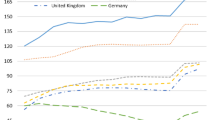Abstract
If different groups of people in a low-income society save at different average rates, a program of birth control may affect the aggregate rate of saving by changing the relative shares of income accruing to these groups. A model is outlined in which this process occurs. The only group that saves is profit recipients; peasants and secondary sector employees consume all their income. A decline in fertility leads to a lower demand for food and a lower price of food. This results in a lower money supply price of labor in the secondary sector, and hence greater profits and greater saving. On the other hand, a fertility decline may eventually produce a higher real standard of living among rural workers, hence a higher supply price of secondary sector labor, lower profits and lower saving. These effects are investigated in a simulation of Mexican economic growth with (a) constant high fertility and (b) a declining birth rate such as might occur if a successful national birth control program were instituted. The birth control program results in a higher rate of aggregate saving over the first several decades, and eventually a lower rate of saving once a higher standard of living has been attained.
Similar content being viewed by others
References
Benitez Zenteno, Raul, and Gustavo Cabrera Acevedo. 1966. Proyecciones de la Poblacion de Mexico, 1960–1980. Mexico City: Banco de Mexico.
Brown, Murray. 1966. On the Theory and Meaurement of Technological Change. Cambridge: Cambridge University Press.
Coale, Ansley J., and Paul Demeny. 1966. Regional Model Life Tables and Stable Populations. Princeton: Princeton University Press.
Coale, Ansley J., and Edgar M. Hoover. 1958. Population Growth and Economic Development in Low-Income Countries: A Case Study of India’s Prospects. Princeton: Princeton University Press.
Departamento de Estudios Economicos. 1969. Cuentas Nacionales y Acervos de Capital, Consolidades y por Tipo de Actividad Eeonomica, 1950–1967. Mexico City: Banco de Mexico.
Fei, John C. H., and Gustav Ranis. 1964. Development of the Labor Surplus Economy; Theory and Policy. Homewood, Ill.: Richard D. Irwin, Inc.
Gutierrez Requenes, Mario. 1969. Producto Bruto Interno y Series Basicas, 1895–1967. Mexico City: Banco de Mexico.
Isbister, John. 1971. Urban Employment and Wages in a Developing Economy: The Case of Mexico. Economic Development and Cultural Change 20:24–46.
Lewis, W. Arthur. 1954. Economic Development with Unlimited Supplies of Labor. Manchester School of Economic and Social Studies 22:139–192.
Reynolds, Clark W. 1970. The Mexican Economy; Twentieth-Century Structure and Growth. New Haven: Yale University Press.
Robinson, Warren C., and David E. Horlacher. 1969. Evaluating the Economic Benefits of Fertility Reduction. Studies in Family Planning 39:4–8.
Secretaria de Industria y Comercio, Direccion General de Estadistica. 1964. VIn Censo General de Poblacion de 1960: Poblacion Economicamente Activa. Mexico City.
Author information
Authors and Affiliations
Rights and permissions
About this article
Cite this article
Isbister, J. Birth control, income redistribution, and the rate of saving: The case of Mexico. Demography 10, 85–98 (1973). https://doi.org/10.2307/2060752
Issue Date:
DOI: https://doi.org/10.2307/2060752




